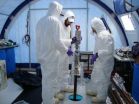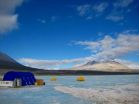(Press-News.org) NEW YORK (November 26, 2012)—Scientists have developed a system to predict the timing and severity of seasonal influenza outbreaks that could one day help health officials and the general public better prepare for them. The system adapts techniques used in modern weather prediction to turn real-time, Web-based estimates of influenza infection into local forecasts of seasonal flu.
Results appear online in the Proceedings of the National Academy of Sciences.
Year to year, and region to region, there is huge variability in the peak of flu season, which, in temperate areas of the Northern Hemisphere, can happen as early as October or as late as April. The forecast system can provide "a window into what can happen week to week as flu prevalence rises and falls," says Jeffrey Shaman, PhD, an assistant professor of Environmental Health Sciences at Columbia University's Mailman School of Public Health.
As a test case, Dr. Shaman and Alicia Karspeck, PhD, of the National Center for Atmospheric Research, used Web-based estimates of flu-related sickness from the 2003-2008 influenza seasons in New York City to retrospectively generate weekly flu forecasts and found that the technique could predict the peak timing of the outbreak more than seven weeks in advance of the actual peak.
In the future, such flu forecasts might conceivably be disseminated on the local television news along with the weather report, says Dr. Shaman. Like the weather, flu conditions vary from region to region; Atlanta might peak weeks ahead of Anchorage. "Because we are all familiar with weather broadcasts, when we hear that there is a 80% chance of rain, we all have an intuitive sense of whether or not we should carry an umbrella," says Dr. Shaman. "I expect we will develop a similar comfort level and confidence in flu forecasts and develop an intuition of what we should do to protect ourselves in response to different forecast outcomes."
As individuals, a flu forecast could prompt us to get a vaccine, exercise care around people sneezing and coughing, and better tune in to how we feel. For health officials, it could inform decisions on how many vaccines and antiviral drugs to stockpile, and in the case of a virulent outbreak, whether other measures, like closing schools, is necessary.
"Flu forecasting has the potential to significantly improve our ability to prepare for and manage the seasonal flu outbreaks that strike each year," says Irene Eckstrand, PhD, of the National Institutes of Health's National Institute of General Medical Sciences, which provided funding for the study.
Worldwide, influenza kills an estimated 250,000 to 500,000 people each year; in the U.S. about 35,000 die from the flu every year.
The seed of the new study was planted four years ago in a conversation between the two researchers, in which Dr. Shaman expressed an interest in using models to forecast influenza. Dr. Karspeck "recommended incorporating some of the data assimilation techniques used in weather forecasting to build a skillful prediction system" remembers Dr. Shaman.
In weather forecasting real-time observational data are used to "nudge the model to conform with reality and reduce error in the model simulations," he explains. Applying this method to flu forecasting, the researchers used near-real-time data from Google Flu Trends, which estimates outbreaks based on the number of flu-related search queries in a given region.
Going forward, Dr. Shaman will test the model in other localities across the country using up-to-date data. This is necessary, he says, since "there is no guarantee that just because the method works in New York it will work in Miami."
INFORMATION:
About Columbia University's Mailman School of Public Health
Founded in 1922 as one of the first three public health academies in the nation, Columbia University's Mailman School of Public Health pursues an agenda of research, education, and service to address the critical and complex public health issues affecting New Yorkers, the nation and the world. The Mailman School is the third largest recipient of NIH grants among schools of public health. Its over 300 multi-disciplinary faculty members work in more than 100 countries around the world, addressing such issues as preventing infectious and chronic diseases, environmental health, maternal and child health, health policy, climate change & health, and public health preparedness. It is a leader in public health education with over 1,000 graduate students from more than 40 nations pursuing a variety of master's and doctoral degree programs. The Mailman School is also home to numerous world-renowned research centers including the International Center for AIDS Care and Treatment Programs (ICAP), the National Center for Disaster Preparedness, and the Center for Infection and Immunity. For more information, please visit www.mailman.columbia.edu
END
Several drugs companies have ineffectively tried to produce antibodies that bind to the IGF-1 receptor on the cell surface, which has a critical part to play in the development of cancer. Scientists at Karolinska Institutet in Sweden have now ascertained how these antibodies work, and can explain why only some cancer patients are helped by IGF-1 blockers during clinical tests. The researchers also present a means by which drugs of this kind could help more cancer patients.
Every cell contains thousands of tiny receptors that help it communicate with other cells. These ...
RENO – This week a pioneering study published in the Proceedings of the National Academy of Sciences (PNAS) and co-authored by Dr. Alison Murray and Dr. Christian Fritsen of Nevada's Desert Research Institute (DRI) reveals, for the first time, a viable community of bacteria that survives and ekes out a living in a dark, salty and subfreezing environment beneath nearly 20 meters of ice in one of Antarctica's most isolated lakes.
Lake Vida, the largest of several unique lakes found in the McMurdo Dry Valleys, contains no oxygen, is mostly frozen and possesses the highest ...
SALT LAKE CITY— Discovery of a new drug with high potential to treat Ewing sarcoma, an often deadly cancer of children and young adults, and the previously unknown mechanism behind it, come hand-in-hand in a new study by researchers from Huntsman Cancer Institute (HCI) at the University of Utah. The report appears in today's online issue of the journal Oncogene.
"Ewing sarcoma is almost always caused by a cancer-causing protein called EWS/FLI," said Stephen Lessnick, M.D., Ph.D., director of HCI's Center for Children's Cancer Research, professor in the Department of ...
Biologists at UC San Diego have demonstrated for the first time that marine algae can be just as capable as fresh water algae in producing biofuels.
The scientists genetically engineered marine algae to produce five different kinds of industrially important enzymes and say the same process they used could be employed to enhance the yield of petroleum-like compounds from these salt water algae. Their achievement is detailed in a paper published online in the current issue of the scientific journal Algal Research.
The ability to genetically transform marine algae into ...
This press release is available in Spanish.
Student engagement is not independent of the type of school attended.Nor is it independent of the organisational development of the school.The school's organisational style affects the work of its teaching staff, which, in turn, has repercussions on the performance and engagement of their students.As IkerRos, the UPV/EHU researcher, has been able to verify in his PhD thesis, these factors vary when comparing public schools, subsidised schools and co-operative schools, the latter being the ones that fare best.
"The study of ...
(NEW YORK, N.Y., November 26, 2012) – Autism Speaks Chief Science Officer Geraldine Dawson, Ph.D. describes how the dramatic progress in autism research has paralleled increased recognition of autism's prevalence and financial impact in the December issue of the Archives of General Psychiatry published on line today. "This issue of the journal features three articles on autism," she writes in her editorial. "A decade ago, the journal published about the same number of autism articles per year."
Dr. Dawson also notes that, while the funding for autism research has dramatically ...
An area of the brain called the orbitofrontal cortex is responsible for decisions made on the spur of the moment, but not those made based on prior experience or habit, according to a new basic science study from substance abuse researchers at the University of Maryland School of Medicine and the National Institute on Drug Abuse (NIDA). Scientists had previously believed that the area of the brain was responsible for both types of behavior and decision-making. The distinction is critical to understanding the neurobiology of decision-making, particularly with regard to substance ...
SAN DIEGO, Calif. (November 26, 2012) The Algae Biomass Organization, the trade association for the U.S. algae industry today hailed the findings of a University of California at San Diego study that concludes, for the first time, that marine (saltwater) algae can be just as capable as freshwater algae in producing biofuels. The research is documented in a peer-reviewed paper published online in the current issue of the scientific journal Algal Research.
"What this means is that you can use ocean water to grow the algae that will be used to produce biofuels. And once ...
EAST LANSING, Mich. — Where there's water there's life – even in brine beneath 60 feet of Antarctic ice, in permanent darkness and subzero temperatures.
While Lake Vida, located in the northernmost of the McMurdo Dry Valleys of East Antarctica, will never be a vacation destination, it is home to some newly discovered hearty microbes. In the current issue of the Proceedings of the National Academy of Sciences, Nathaniel Ostrom, Michigan State University zoologist, has co-authored "Microbial Life at -13ºC in the Brine of an Ice-Sealed Antarctic Lake."
Ostrom was part ...
The wild and dramatic cascade of ice into the ocean from Alaska's Columbia Glacier, an iconic glacier featured in the documentary "Chasing Ice" and one of the fastest moving glaciers in the world, will cease around 2020, according to a study by the University of Colorado Boulder.
A computer model predicts the retreat of the Columbia Glacier will stop when the glacier reaches a new stable position -- roughly 15 miles upstream from the stable position it occupied prior to the 1980s. The team, headed by lead author William Colgan of the CU-Boulder headquartered Cooperative ...



